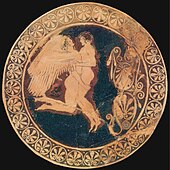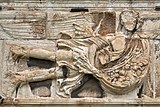Anemoi

Inancient Greek religionandmyth,theAnemoi(Greek:Ἄνεμοι,"Winds" ) were wind gods who were each ascribed acardinal directionfrom which their respective winds came (seeClassical compass winds), and were each associated with variousnature,seasonsandweatherconditions. They were the progeny of thegoddess of the dawnEosand her husband, the god of the dusk,Astraeus.[1]
Etymology
[edit]The earliest attestation of the word in Greek and of the worship of the winds by the Greeks, are perhaps theMycenaean Greekword-forms𐀀𐀚𐀗𐀂𐀋𐀩𐀊,a-ne-mo-i-je-re-ja,𐀀𐀚𐀗𐄀𐀂𐀋𐀩𐀊,a-ne-mo,i-je-re-ja,i.e. "priestess of the winds". These words, written inLinear B,are found on theKNFp 1 and KN Fp 13 tablets.[2][3]
Mythology
[edit]
The Anemoi are minor gods and are subject to the godAeolus.They were sometimes represented asgusts of wind,and at other times were personified aswingedmen. They were also sometimes depicted ashorseskept in the stables of the storm god Aeolus, who providedOdysseuswith the Anemoi in theOdyssey.TheSpartanswere reported to sacrifice a horse to the winds onMount Taygetus.[4]Astraeus,the astrological deity (sometimes associated withAeolus), andEos/Aurora,the goddess of thedawn,were the parents of the Anemoi, according to theGreekpoetHesiod.
Of the four chief Anemoi,Boreas(Aquilo inRoman mythology) is the north wind and bringer of cold winter air,Zephyrus(Favonius inLatin)[5]is the west wind and bringer of light spring and early-summer breezes, andNotus(Auster inLatin) is the south wind and bringer of the storms of late summer and autumn;Eurus,the southeast[6](or according to some,[7]the east) wind, was not associated with any of the threeGreek seasons,and is the only one of these four Anemoi not mentioned in Hesiod'sTheogonyor in theOrphic Hymns.
The deities equivalent to the Anemoi inRoman mythologywere theVenti(Latin,"winds" ).[citation needed]These gods had different names, but were otherwise very similar to their Greek counterparts, borrowing their attributes and being frequently conflated with them. Ptolemy's world map listed 12 winds: Septentrio (N), Aquilo (NNE), Vulturnus (NE), Subsolanus (E), Eurus (SE), Euroauster (SSE), Austeronotus (S), Euronotus (SSW), Africus (SW), Zephirus (W), Eurus (NW), Circius (NNW).
Boreas (Aquilo)
[edit]Boreas is the god of the north wind and the harshest of the Anemoi. He is mostly known for his abduction of the Athenian princessOrithyia,by whom he became the father of theBoreads.In art, he is usually depicted as a bearded, older man. His Roman equivalent is calledAquilo.
Zephyrus (Favonius)
[edit]


Zephyrus (Gk.Ζέφυρος[Zéphyros]),[5]sometimes shortened in English toZephyr,is the Greek god of thewest wind.The gentlest of the winds, Zephyrus is known as the fructifying wind, the messenger of spring. It was thought that Zephyrus lived in a cave inThrace.
Zephyrus was reported as having several wives in different stories. He was said to be the husband ofIris,goddess of the rainbow. He abducted the goddessChloris,and gave her the domain of flowers. With Chloris, he fatheredKarpos('fruit'). He is said to have vied forChloris'slove with his brother Boreas, eventually winning her devotion. Additionally, with yet another sister and lover, theharpyPodarge(also known asCelaeno), Zephyrus was said to be the father ofBalius and Xanthus,Achilles' horses.
In the story ofEros and Psyche,Zephyrus servedEros(or Cupid) by transporting Psyche to his abode.
Zephyrus was also claimed to have killed one of Apollo's many male loversHyacinthout of jealousy. Hyacinth was killed by a discus thrown by Apollo. Though according to some sources, his death was said to be an accident, others said that Zephyrus was the true culprit, having blown the discus off course.
Notus (Auster)
[edit]Notus(Νότος,Nótos) was the Greek god of thesouth wind.He was associated with the desiccating hot wind of the rise ofSiriusaftermidsummer,was thought to bring the storms of late summer and early autumn, and was feared as a destroyer of crops.[8]

Notus' equivalent in Roman mythology was Auster, the embodiment of thesiroccowind, a southerly wind which brings cloudy weather, powerful winds and rain to southern Europe. (Austernamed thecompasspointAustralisand the country's nameAustralia.) The Auster winds are mentioned inVirgil'sAeneidBook II, lines 304–307:
in segetem veluti cum flamma furentibus Austris incidit, |
Just as when a flame falls on the standing grain while the South Winds rage, |
Another Roman poet,Tibullus1.1, lines 47–48, speaks of the pleasure of lying in bed on rainy winter days:
aut, gelidas hibernus aquas cum fuderit Auster, |
or when the winter South Wind has poured out his cold waters, |
The nameAustralia(the "southern land" ) is derived fromAuster.[9]
Eurus (Vulturnus)
[edit]Eurus(Εὖρος,Euros) according to some was the southeast wind, but according to others the east wind.[7]On theTower of the Windsin Athens, Eurus occupies the southeast side, while Apeliotes is in the east. However, it is widely accepted[by whom?]that Eurus is the east wind, while Apeliotes is the southeast wind.
Eurus' Roman counterpart isVulturnus,according toPliny the Elder;[10]but forAulus GelliusVolturnus was the equivalent of the southeast wind Euronotus.[11]In the Latin poems, the nameEurusis generally used for the east or southeast wind, as in Greek.[12]
Eurus is a wind of storm, described as a turbulent wind during storms and tossing ships on the sea.[13][14]He is referred to as the "savior of Sparta" in a Homericpaean,or poem.[15]Eurus is also called the "hot wind" by Nonnus inDionysiaca.Eurus is closely related to Helios in passages of the Dionysiaca, being called from his place nearHelios' palace, Phaethon, where the sun rose in the east.[16]
Lesser winds
[edit]Four lesser wind deities appear in a few ancient sources, such as at theTower of the Windsin Athens:
Kaikias(or Caecius) is the Greek deity of the northeast wind. He is shown on the monument as a bearded man with a shield full of hailstones.
Apeliotes(or Apheliotes; the name means 'from the (rising) sun') is the Greek deity of the southeast wind.[17]As this wind was thought to cause a refreshing rain particularly beneficial to farmers, he is often depicted wearing high boots and carrying fruit, draped in a light cloth concealing some flowers or grain. He is clean-shaven, with curly hair and a friendly expression. Because Apeliotes is a minor god, he was often syncretized with Eurus, the east wind.[citation needed]The Roman counterpart of Apeliotes isSubsolanus.[18]
Skironwas the name used in Athens for the wind which blew from the Scironian rocks (a geographical feature nearKinetato the west of Athens).[19]On theTower of the Winds,however, he appears on the northwest side. His name is related toSkirophorion,the last of the three months of spring in theAttic calendar.He is depicted as a bearded man tilting a cauldron, representing the onset of winter. His Roman counterpart isCaurus[20]orCorus.[21]Caurus is also one of the oldest Roman wind-deities, and numbered among thedi indigetes('indigenous gods'), a group of abstract and largely minornuminousentities. The Roman poetVirgilwrites when describing steppe winter weather near theSea of Azov:[22]
Semper hiemps, semper spirantes frigora cauri |
Always winter, always the northwest winds breathing cold |
Lipsis the Greek deity of the southwest wind, often depicted holding thesternof a ship. His Roman equivalent wasAfricus,due to the Roman provinceAfricabeing to the southwest ofItaly.This name is thought to be derived from the name of aNorth Africantribe, theAfri.
Other minor wind deities included:
- Argestes"clearing", a wind blowing from about the same direction as Skiron (Caurus), and probably another name for it
- Aparctias,sometimes called the north wind instead of Boreas
- Thrascias,the north-northwest wind (sometimes called in Latin Circius)
- Euronotus,the wind blowing from the direction, as its name suggests, between Euros and Notus, that is, a south-southeast wind (Euroausterto the Romans)
- Iapyx,the northwest wind about the same as Caurus. It was this wind, according toVirgil,that carried the fleeingCleopatrahome to Egypt after she was defeated at thebattle of Actium.[23]
- Libonotus,the south-southwest wind, known asAustro-Africusto the Romans
- Meses,another name for the northwest wind
- Olympias,apparently identified with Skiron/Argestes
- Phoenicias,another name for the southeast wind ('the one blowing fromPhoenicia', due to this land lying to the southeast of Greece)
See also
[edit]- Anemometer,modern device to measure wind
- Bacab
- Dáinn, Dvalinn, Duneyrr and Duraþrór
- Norðri, Suðri, Austri and Vestri
- Vayu
- List of wind deities
References
[edit]- ^Roman, L., & Roman, M. (2010).Encyclopedia of Greek and Roman mythology.,p. 66, atGoogle Books
- ^Raymoure, K.A."a-ne-mo".Linear B Transliterations.Deaditerranean. Dead Languages of the Mediterranean. Archived fromthe originalon 2019-02-12.Retrieved2014-03-28."KN Fp 1 + 31"."KN 13 Fp(1) (138)".
- ^"DĀMOS: Database of Mycenaean at Oslo - Department of Philosophy, Classics, History of Art and Ideas".
- ^Pausanias2.34.2 compared byFestusto the Roman sacrifice of theOctober Horse,190 in the edition of Lindsay.
- ^abAulus Gellius 2.22.12.
- ^Liddell, Scott, & Jones Greek Lexicon.
- ^abLewis and Short, Latin Dictionary.
- ^"Google Image Result for".Google.ca.Retrieved2013-05-07.
- ^Online etymological dictionary.
- ^Pliny the Elder 2.46; cf. Columella 15
- ^Aulus Gellius, 2.22.1.
- ^e.g. Virgil, Aen. 12.730, Horace, Odes 2.16, Ovid, Met. 15.552.
- ^"EURUS (Euros) - Greek God of the East Wind".theoi.Retrieved2020-04-28.
- ^Valerius Flaccus. The Argonautica. Translation by Mozley, J. H. Loeb Classical Library. Cambridge, Massachusetts: Harvard University Press. Book 1, ff 346, 574, 640. Book 2, ff 356.
- ^Greek Lyric V New School of Poetry and Anonymous Songs. Translation by Campbell, D. A. Loeb Classical Library Vol 144. Frag. 858 (from Strasbourg papyrus).Massachusetts: Harvard University Press.
- ^Nonnus, Dionysiaca. Translated by Rouse, W H D. Book 3(ff 55) and 37 (ff. 55, ff 86). Loeb Classical Library Volumes 344, 354, 356. Cambridge, MA, Harvard University Press, 1940.
- ^Liddell, Scott & Jones, Greek Lexicon.
- ^Aulus Gellius 2.22.1; Pliny the Elder 2.46.
- ^Liddell, Scott, & Jones, Greek Lexicon.
- ^Vitruvius 1.6.13.
- ^Lucretius 1.405. Pliny the Elder 2.48.
- ^Virgil, Georgics, 3.356.
- ^Hdt. 7.189.3.
Further reading
[edit]- Apollonius of Rhodes,Apollonius Rhodius: the Argonautica,translated by Robert Cooper Seaton, W. Heinemann, 1912.Internet Archive.
- Aristotle,Meteorologica,2.6
- Aulus Gellius,Attic Nights,2. 22
- Grimal, Pierre,The Dictionary of Classical Mythology,Wiley-Blackwell, 1996.ISBN978-0-631-20102-1.
- Herodotus,The Historieswith an English translation by A. D. Godley. Cambridge. Harvard University Press. 1920.Online version at the Topos Text Project.Greek text available at Perseus Digital Library.
- March, J. (1999).Cassell's Dictionary Of Classical Mythology.London.ISBN0-304-35161-X.
- Pausanias,Description of Greecewith an English Translation by W.H.S. Jones, Litt.D., and H.A. Ormerod, M.A., in 4 Volumes. Cambridge, MA, Harvard University Press; London, William Heinemann Ltd. 1918.Online version at the Perseus Digital Library
- Pausanias,Graeciae Descriptio.3 vols.Leipzig, Teubner. 1903.Greek text available at the Perseus Digital Library.
- Pliny the Elder,The Natural History.John Bostock, M.D., F.R.S. H.T. Riley, Esq., B.A. London. Taylor and Francis, Red Lion Court, Fleet Street. 1855.Online version at the Perseus Digital Library.
- Pliny the Elder,Naturalis Historia.Karl Friedrich Theodor Mayhoff. Lipsiae. Teubner. 1906.Latin text available at the Perseus Digital Library.
- Publius Vergilius Maro,Aeneid.Theodore C. Williams. trans. Boston. Houghton Mifflin Co. 1910.Online version at the Perseus Digital Library.
- Publius Vergilius Maro,Bucolics, Aeneid, and Georgics.J. B. Greenough. Boston. Ginn & Co. 1900.Latin text available at the Perseus Digital Library.
- Publius Vergilius Maro,Bucolics,Aeneid, and Georgics of Vergil.J. B. Greenough. Boston. Ginn & Co. 1900.Online version at the Perseus Digital Library.
External links
[edit] Media related toAnemoiat Wikimedia Commons
Media related toAnemoiat Wikimedia Commons- Warburg Institute Iconographic Database (ca 50 images of winds)
- Drawings of the eight winds on the Tower of the Winds at Athens




